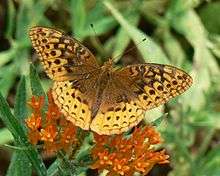Speyeria
Speyeria, commonly known as greater fritillaries, is a genus of butterflies in the family Nymphalidae commonly found in North America, Europe, and Asia. Some authors used to consider this taxon a subgenus of Argynnis, but it has been reestablished as a separate genus in 2017.[1]
| Greater fritillaries | |
|---|---|
 | |
| Speyeria cybele feeding on Asclepias tuberosa. | |
| Scientific classification | |
| Kingdom: | Animalia |
| Phylum: | Arthropoda |
| Class: | Insecta |
| Order: | Lepidoptera |
| Family: | Nymphalidae |
| Tribe: | Argynnini |
| Genus: | Speyeria Scudder, 1872 |
| Species | |
|
See text | |
Species
The genus has 3 species in Eurasia (these were formerly known as genus Mesoacidalia, now a synonym of Speyeria):
- Speyeria aglaja (Linnaeus, 1758) – Dark green fritillary
- Speyeria alexandra (Ménétriés, 1832)
- Speyeria clara (Blanchard, [1844])
and 16 species in North America:[1]
- Speyeria diana (Cramer, [1777]) – Diana fritillary
- Speyeria cybele (Fabricius, 1775) – great spangled fritillary
- Speyeria aphrodite (Fabricius, 1787) – Aphrodite fritillary
- Speyeria idalia (Drury, [1773]) – regal fritillary
- Speyeria nokomis (Edwards, 1862) – Nokomis fritillary
- Speyeria edwardsii (Reakirt, 1866) – Edward's fritillary
- Speyeria coronis (Behr, 1864) – Coronis fritillary
- Speyeria zerene (Boisduval, 1852) – zerene fritillary
- Speyeria carolae (dos Passos & Grey, 1942) – Carole's fritillary
- Speyeria callippe (Boisduval, 1852) – callippe fritillary
- Speyeria egleis (Behr, 1863) – Egleis fritillary
- Speyeria adiaste (Edwards, 1864) – unsilvered fritillary or Adiaste fritillary
- Speyeria atlantis (Edwards, 1862) – Atlantis fritillary
- Speyeria hesperis (Edwards, 1864) – northwestern fritillary
- Speyeria hydaspe (Boisduval, 1869) – Hydaspe fritillary
- Speyeria mormonia (Boisduval, 1869) – Mormon fritillary
gollark: How does one do that?
gollark: Was it not <@217026209752678401> complaining?
gollark: ```Shulkers spawn during generation of end cities, which are located on the outer islands of the End. They usually spawn on the walls of the city. They don't despawn naturally, even in Peaceful difficulty, and once killed, they don't respawn.```https://minecraft.gamepedia.com/ShulkerWe can't blame CLNinja5cn for *every* scarcity issue.
gollark: *checks wi'iki*
gollark: Wait, shulkers are refilled by the dragon being spawned?
References
- Savela, Markku. "Speyeria Scudder, 1872". Lepidoptera and Some Other Life Forms. Retrieved October 1, 2019.
| Wikimedia Commons has media related to Speyeria. |
| Wikispecies has information related to Speyeria |
Further reading
- Glassberg, Jeffrey (2001). Butterflies through Binoculars: The West.
- Guppy, Crispin S. and Shepard, Jon H. (2001). Butterflies of British Columbia.
- James, David G. and Nunnallee, David (2011). Life Histories of Cascadia Butterflies.
- Pelham, Jonathan (2008). Catalogue of the Butterflies of the United States and Canada.
- Pyle, Robert Michael (2002). The Butterflies of Cascadia.
- De Moya, Robert S.; Savage, Wesley K.; Tenney, Chris; Bao, Xiaoshan; Wahlberg, Niklas; Hill, Ryan I. (2017). "Interrelationships and diversification of Argynnis Fabricius and Speyeria Scudder butterflies". Systematic Entomology. 42 (4): 635–649. doi:10.1111/syen.12236.
- Campbell, Erin O.; Gage, Edward V.; Gage, Randy V.; Sperling, Felix A. H. (2020). "Single nucleotide polymorphism‐based species phylogeny of greater fritillary butterflies (Lepidoptera: Nymphalidae: Speyeria) demonstrates widespread mitonuclear discordance". Systematic Entomology. 45 (2): 269–280. doi:10.1111/syen.12393.
This article is issued from Wikipedia. The text is licensed under Creative Commons - Attribution - Sharealike. Additional terms may apply for the media files.